Jesus, it’s the end of another year. I’ve had fun in 2007; being a part of the anime blogging community and writing for you, dear reader. I’m not sure I’d last long if it wasn’t for your comments, but here we are, almost two years on and still talking, ranting, in love with anime. Back during September, I was wondering if I’d ever just suddenly grow out of all this, stop blogging and disappear, but deep down, the truth has never been in doubt; I’m an anime fan forever and you’ll take this passion, these feelings, when you pry them from my cold dead fingers. This review of 2007 begins now.
 13. Bokurano
13. Bokurano
For all my hyping of Bokurano, the anime adaptation ended up being woefully mediocre. Much like their similarly soulless treatment of other good horror manga like Gantz and Hellsing, Gonzo’s vision of Bokurano was poorly animated and depressing, almost completely lacking in the "beautiful tragedy", truth and innocence that permeates Mohiro Kitoh’s brilliant original story. For an anime studio capable of producing epic series like Gankutsuou and Last Exile, 2007 was an utter failure for Gonzo, but don’t worry, Afro Samurai 2 will be here soon; that’s going to be good, right?
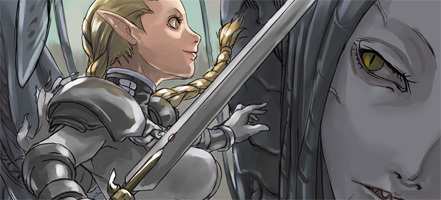 12. Claymore
12. Claymore
Claymore is an inferior clone of Berserk. The Awakened Beings are Apostles, Isley looks a lot like Griffith and Rigardo is a replica of Zodd. That being said, I like dark fantasy and Claymore was good enough on a superficial level to entertain and occasionally capture my imagination. It was violent and harsh, but I rarely felt like I cared about the characters, and by the end, the rushed climax had further degenerated into a predictable sequence of grunts and power-ups. Berserk is amongst the finest anime of all time, this isn’t.
 11. Mononoke
11. Mononoke
I really want to love Mononoke; it’s beautifully animated, artsy and daringly creative, but still, I find it somewhat elusive. I feel like it exists simply to be as elegant, surreal and weird as possible; 23 minutes later, the episode has finished and I’ll move on to something else. It’s a lot like Mushishi; episodic and few-to-none recurring characters, but where that’s magical, reflective and relaxed, Mononoke is an ultra-violet and ambiguous puzzle.
 10. Darker Than Black
10. Darker Than Black
Nothing’s worse than wasted potential. For Darker Than Black, Studio Bones reunited a lot of the staff involved in the mesmeric Wolf’s Rain, including maestro Yoko Kanno and director Tensai Okamura, but other than brief glimpses of former glory, this was just another "good" series which never really found it’s own identity. The story arcs would pointlessly leap between hard-boiled drama, stupid comedy and comic-book horror, but without any of the comradery or personality seen in the likes of Cowboy Bebop, it regularly came across as false and ultimately, a forgettable disappointment.
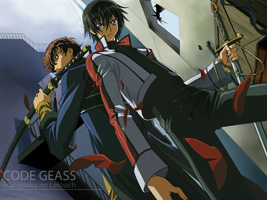 9. Code Geass
9. Code Geass
I’m a tad embarrassed to admit I enjoyed watching Code Geass. Let’s get something straight, it’s an utter mongrel of an anime series ripe with cliche fan-service, mecha and an anti-hero ripped straight out of Death Note. Hell, it’s even sponsored by Pizza Hut. With all that said, I won’t deny that this show had me riveted from start ’til end; much like watching a giant train wreck, I simply enjoy seeing it all go off the rails (that’s a metaphor, I don’t actually watch footage of train wrecks). No doubt, Code Geass is a sensational failure, but sensational none the less.
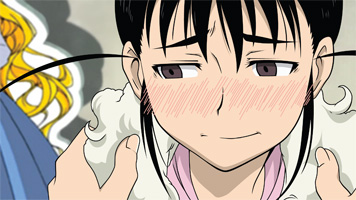 8. Genshiken 2
8. Genshiken 2
I’ve always liked Genshiken. It’s perceptive and funny, and certainly fits being labeled as "slice of life", as it’s also meandering and aimless. Its quality and its failing is that it’s a quite literal depiction of otaku life, and in general, life is aimless and meandering; there is no grand design we’re all following (if you haven’t guessed, I’m not especially religious), we simply are, and that’s it. Genshiken 2’s beauty is in depicting this transience, there is a palpable realization amongst the characters that they’re growing apart the way we all do; they are prepared for it, this parting of the ways, but it’s sad to see none the less. You won’t quit on me yet, guys?
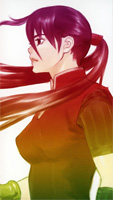 7. Seirei no Moribito
7. Seirei no Moribito
The third episode of Seirei no Moribito is probably the singe best episode of anime I’ve seen all year. The action, intensity, music and animation were all top notch, but gradually, everything slowed down and the story moved in a completely different direction. Within ten episodes, we had traveled (quite literally) from an utterly compelling sequence of cool action scenes to something more akin to an intimate family drama. Of course, Seirei no Moribito remains a beautifully animated fantasy, but it feels over-long and ultimately, strikes a slightly uneven balance between big explosions and quiet sentimentality.
 6. Shigurui
6. Shigurui
The thought of violence in anime almost immediately conjures fountains of bright red blood and contorted screams, yet there is little in the way of genuine sadism. Step forward Shigurui; a series that takes pleasure in lingering on impact, ensuring we flinch with every punctured eye-ball and severed nipple. This is animation madly in love with the human body and almost sadomasochist in its intent to contort, scar and rip the flesh. Set in a time when traditions and morals were twisted and forced, it’s hard to recommend something as outright disturbing and serious as this, yet it’s so fascinating and meticulous; humanity at its basest level.
 5. Baccano!
5. Baccano!
Anime tends to specialize in characters and relationships, but the pleasure in watching Baccano! is simply in seeing a particularly intricate story gradually reveal its labyrinth of secrets. Every episode is consistently dense with mystery and intrigue as we are dragged back and forth in time to reveal untold depths of supernatural power and immortal betrayal. The rather slapstick humor is often at odds with surprising levels of cruelty and gore but best of all is an exciting sequence of action escalating on-top of a moving train.
 4. Death Note
4. Death Note
I sat down with Death Note having carefully avoided the manga spoilers for what felt like an eternity and was rewarded with a thrilling and addictive story that’s constantly asking questions of its viewers. Between his infamous games of brinkmanship with L and the rest, we’re regularly questioning Light’s motives for using his Death Note. Though he’s striving for, and even getting close to world peace, does that justify his mass-murdering spree? Or rather, is he just another sly megalomaniac enjoying his pointless power trip? It’s a great feeling to discover a story like this, something that’s still capable of creating new ideas and playing with our concepts of justice and heroism without ever resorting to a tacked-on happy ending. Light is the main character, yet he is a villain; an insane bastard who’s playing with lives simply because he’s bored. He deserves his end, and yet, when everything inevitably crashes down, I feel pity, I don’t want him to die. I liked the second opening, too!
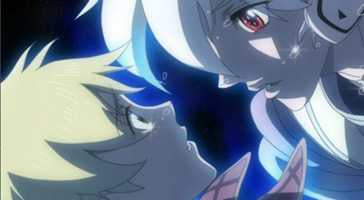 3. Toward the Terra
3. Toward the Terra
I never really expected to like (let alone love) Toward the Terra. Though I’m always willing to give honest science fiction a fair crack, this didn’t have the best of starts. I stopped watching Heroic Age because it was stupid and boring, but around about the same time, my opinion of Toward the Terra was changing; perhaps it was the use of time-leaps — we see these heroes and villains grow over time, how they change from whiney children into strong and conflicted adults; with each passing episode, there is a sense that we know these characters, understand their grief and desires. Aside from some positively epic genocide (exploding planets), the heart of what’s great about Toward the Terra is this compelling battle of wills between Jomy and Keith, we’re constantly wondering whether or not Keith can cast aside everything he’s been taught and embrace the Mu for what they are, while Jomy continues to struggle with his thirst of revenge and perpetuating the cycle of violence. Toward the Terra has a lot to say about racism and discrimination, but it’s also exciting, action-packed and riddled with tragedy; a great story, set amongst the stars, that plays out over decades of time.
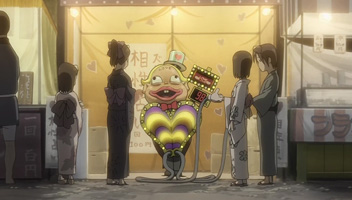 2. Dennou Coil
2. Dennou Coil
Good animation goes a long way to attracting my interest in a series and what’s immediately apparent about Dennou Coil is that it’s vibrant and full of life. It’s like everything moves, everything is considered, and you’re watching someone literally imprint their thoughts and dreams onto a frame. At its best, that’s how it feels to watch Dennou Coil, it’s like someone’s vivid memories of childhood suddenly sprung to life, the neon colors and honest fun of those days, the half-formed hints of emotions fraying between friends and mingling with some pointless adventure. There is that sense of not really being able to express yourself, despite everything about you; the way you look and the way you sound, even the way you stand, making it seem so obvious how you feel.
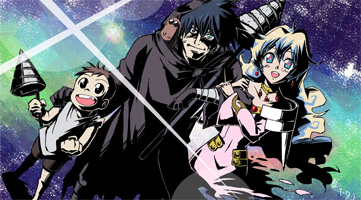 1. Tengen Toppa Gurren Lagann
1. Tengen Toppa Gurren Lagann
To be honest, it seems like everyone loves Gurren Lagann, and though I didn’t want this countdown to be that predictable, the truth is that, almost from the first episode, I was head over heels in love with this show too. No other series would so consistently leave me burning with passion after every episode; leave me feeling like I just had to write about it, as if it were my duty to report how I felt. All you need to see is that opening minute of the first episode, "so all the heavenly lights are the enemy?" This one moment encapsulates so much of what’s good about Gurren Lagann; the impossibly epic scale, the insurmountable odds facing the Gurren-dan and Simon’s brash, unbeatable confidence. It’s mind blowing, and just seeing that, I knew I’d love this series.
I’m desperately trying to keep this short, but there is still so much to say, like how "Libera me from Hell" is such a weird yet great song, or how the story delivers heart warming ideas of friendship, comradery, love and even sacrifice. It ends perfectly, too; bitter-sweet and sad, time having taken its toll on our heroes, yet it just feels right, like everything that needed to be said has been screamed from the highest mountain, and now it’s time to step back, stop fighting and embrace the future. Gurren Lagann is, by far and away, the best anime series of 2007.
Tag: Seirei no Moribito

As any fans of Evangelion will attest, it’s rare to finish an anime series and find ourselves contented enough to walk away knowing “everything is tied up into a neat little package”, yet that is the case with the recently concluded Guardian of the Sacred Spirit (a.k.a Seirei no Moribito). An (evil) part of me will always demand an epic train-wreck, a sensational massacre of violence, death and angst, but deep down, I always knew it would never happen with straight-laced Seirei no Moribito – it was certainly predictable; morally as straight as an arrow, and that’s not necessarily a bad thing.

With September in full swing, we find ourselves on the verge of the 2007 fall season. What? Already? I’m not prepared for any of that new stuff yet; it’s still too early for all these fall previews, autumn can go fuck itself. On the other hand, I’m still hopelessly devoted to a number of currently running series; hence this post, so end intro and cue this countdown of my favorites.
It’s been a few years since I last enjoyed a Production I.G. TV series. The "mega-hit" Blood+ was a safe and predictable action series, while the elegant period setting of Le Chevalier D`Eon was dull and uninspired. All that is to say, I suppose I was expecting to be bored when watching Seirei no Moribito (a.k.a Guardian of the Sacred Spirit); it’s funny how wrong one’s expectations can be, and it’s subsequently great to be proven so profoundly wrong.
Based on the first of 10 fantasy novels by Shihoko Uehashi, Seirei no Moribito follows a precocious female warrior turned bodyguard called Balsa. The story so far is that it’s her job to protect the young Prince Chagum, a kind hearted member of the Royal family who has been "possessed by a water spirit" and since targeted for assassination by his own father (the Emperor). Amidst flames and confusion, Balsa flees the royal palace with Chagum in tow, hunted by the Emperor’s finest warriors.
Let’s get this obvious fact out of the way; Seirei no Moribito is a gorgeous example of high budget animation. With Production I.G., you expect lavish and detailed background art, but rarely do you see such objective, rural beauty in an anime TV series. Only Mushishi comes close to this obsessive reflection of nature. The art director is Yusuke Takeda, who was also behind both the stylised look Gankutsuou and the grandiose feel of Giant Robo. Takeda’s got talent.
It’s obvious that Seirei no Moribito is based on a novel, not only is the story deceptively straight forward and unconcerned with pointless details, the characterisation is striking and unique; the product of a seasoned and talented writer. Chagum isn’t the stuck up prince we expect him to be and Balsa isn’t a cold and efficient killer either, their personalities feel essentially human, different to what we expect.
It’s hard to write a review when you enjoy something so much, but stick with me; I’m not saying all this just to fill time. The director is Kenji Kamiyama, he of Stand Alone Complex fame. Indeed, Kamiyama is a steady and assured hand, never attempting to impose a distinct style on the narrative, preferring instead to let the story unfold at a natural pace.
No doubt, the soundtrack is my favourite of the spring season. It’s composed by the world famous Kenji Kawai, revered for his work on the Ghost in the Shell movies. Here his ethereal, emotional music bleeds into the animation, giving absolute life and emotion to the landscapes and wildlife that surrounds the characters. It’s particularly notable when Chagum scales a slippery, dangerous cliff. At the top, he finds a wolf; the background is filled with rain and lightning, the fearsome animal stands there starring at him, then just turns around and walks back down the cliff. The music during this moment is a heart stopping and tense epic; I need the soundtrack now!
I’ve saved the best for last; the action. I thought Tengen Toppa Gurren Lagann had some fluid hand to hand combat, but episode 3 of Seirei no Moribito rivals the famous "rain" episode from Samurai Champloo. The warrior costumes, their unconventional weapons (spears!) and the actual battle choreography is absolutely electric. There is no real "style" or posing to speak of; it’s real fighting, skirmishes that are often over within 10 seconds, but what a 10 seconds!
It’s hard to summarise a series I’ve enjoyed watching as much as the first three episodes of Seirei no Moribito. It’s already licensed by Geneon in the US, so expect a DVD release state-side soon enough, and the actual novels are going to be published too (in North America by Scholastic). Since Seirei no Moribito is simply the first book, I can only hope that this is the beginning of another big franchise for Production I.G.